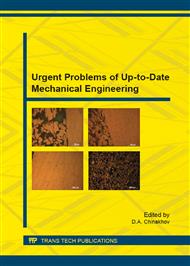[1]
M. Luke, I. Varfolomeev, K. Lutkepohl, A. Esderts, Fatigue crack growth in railway axles: Assessment concept, J. Eng. Fract. Mech. 78 (2011) 714-730.
DOI: 10.1016/j.engfracmech.2010.11.024
Google Scholar
[2]
I. Le May, A.K. Koul, R.V. Daintyt, Fracture Mechanisms in a Series of Locomotive Axle Failures, J. Mat. Charact. 26 (1991) 235-251.
DOI: 10.1016/1044-5803(91)90015-v
Google Scholar
[3]
S. Beretta, A. Ghidini, F. Lombardo, Fracture mechanics and scale effects in the fatigue of railway axles, J. Eng. Fract. Mech. 72 (2003) 195-208.
DOI: 10.1016/j.engfracmech.2003.12.011
Google Scholar
[4]
H. Alihosseini, K. Dehghani, Modelling and failure analysis of a broken railway axle: effects of surface defects and inclusions, J. of Failure Anal. and Prevent. 10 (2010) 233-239.
DOI: 10.1007/s11668-010-9340-0
Google Scholar
[5]
D.S. Hoddionott, Railway axle failure investigations and fatigue crack growth monitoring of an axle. Proceedings of the Institution of Mechanical Engineers, Part F: J. Journal of Rail and Rapid Transit, 2004, 218, 283-292.
DOI: 10.1243/0954409043125897
Google Scholar
[6]
H. Tada, P.C. Paris, G.R. Irwin, The stress analysis of cracks handbook, Saint Louis, MO: Paris Productions Inc., (1985).
Google Scholar
[7]
O. Yasniy, Y. Lapusta, Y. Pyndus, A. Sorochak, V. Yasniy, Assessment of lifetime of railway axle, J. Int. J. of Fatigue, 50 (2013) 40-46.
DOI: 10.1016/j.ijfatigue.2012.04.008
Google Scholar
[8]
ASTM E647-13ae1, Standard Test Method for Measurement of Fatigue Crack Growth Rates, ASTM International, West Conshohocken, PA, (2013).
Google Scholar
[9]
P.O. Maruschak, I.V. Konovalenko, E.V. Maruschak, A.P. Sorochak, Automated method for stereometric study of fatigue failure mechanisms, J. Metallurgist, 58 (2014) 43-47.
DOI: 10.1007/s11015-014-9866-6
Google Scholar
[10]
K. Slamecka, J. Pokluda, P. Ponizil, S. Major, P. Sandera, On the topography of fracture surfaces in bending-torsion fatigue, J. Eng. Fract. Mech. 75 (2008) 760-767.
DOI: 10.1016/j.engfracmech.2007.01.018
Google Scholar
[11]
P. Pokorny, L. Nahlik, P. Hutar, Influence of different crack propagation rate descriptions on the residual fatigue lifetime of railway axles, J. Key Eng. Mat. 627 (2015) 469-472.
DOI: 10.4028/www.scientific.net/kem.627.469
Google Scholar
[12]
P.O. Maruschak, A.P. Sorochak, A. Menou, O.V. Maruschak Regularities in macro- and micromechanisms of fatigue crack growth in a bimetal of continuous caster rolls, J. Case Studies in Eng. and Fail. Anal. 1 (2013) 165–170.
DOI: 10.1016/j.csefa.2013.05.003
Google Scholar


